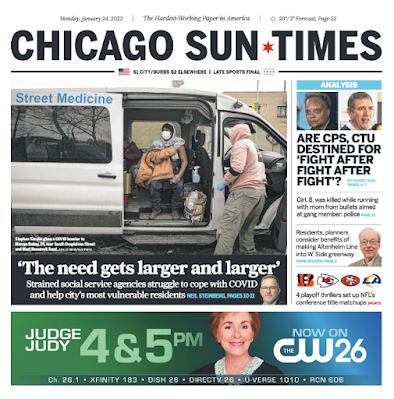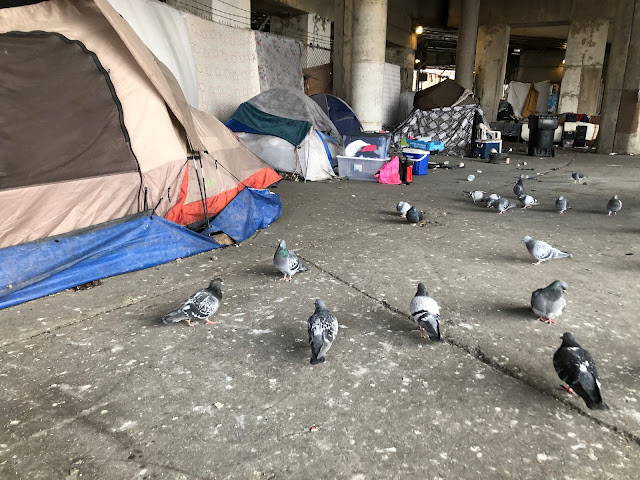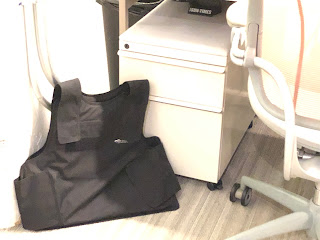For the second, concept, consider Duchamp's "Fountain"—a urinal presented as art in 1917. That is also art, while an actual urinal in a restroom is not, because of the radical idea behind Duchamps provocation (that anything can be art, ironically).
As for the last, impact, think of Christo's "Running Fence." I can't vouch for the execution, the skill with which he draped the orange fabric. And it was the same idea he had been flogging for 50 years: wrap something.
But to see it, in Central Park, was powerful. That's also art.
When I went to the opening of Tony Fitzpatrick's show "Jesus of Western Avenue" at the Cleve Carney Museum in Glen Ellyn, way back in the middle of October, a fourth definition came to me.
Which is ironic, because I really didn't go for the paintings/drawings/ collages, fabulous as they are, with their colorful birds set against explosions of words and logos and tidbits, like a cloud of memories scattershot out of Tony's restless mind. I've seen those, at other galleries, heck, in Tony's studio, being made. I went because he's a friend, and friends show up for that kind of thing.
It was only looking at the paintings in the museum that something struck me. You kinda have to be here, in front of the work. They just aren't the same in reproduction. The colors are the same. The images, the same. But in reproduction they lack the depth—part of his designs are ephemera, logos and bits of found design, layered upon the surface. Reproductions are close, but no cigar.
So that's another definition of art: something that can't be reproduced, not without losing a vital quality. You've no doubt seen bits of Michelangelo's ceiling of the Sistine Chapel—God touching Adam's finger maybe. Photos. But unless you fly to Rome, go to the Vatican, shuffle into the Sistine Chapel and look up, you really haven't seen it. Not at all. To compare the two, is like comparing a recipe to a sonnet.
Not that I'm comparing Michelangelo with Tony Fitzpatrick: Tony would be the first to shoot me a what-the-fuck? glance for that. Though Tony was very busy during COVID, despite some health concerns of his own, and the good news is the work isn't any the worse for it. If anything, it's better, more luminous, more stunning. I meant to write something about it, but the media jumped in quicker than I could, and there didn't seem much point in my leaping up and joining in the applause.
But the show closes Jan. 31. So you've got a few days still. And Tony says it's his last museum show, though I'm not sure I believe him. "You mean when the Art Institute asks, you'll say 'No'?" is how I put it. Better late than never. I do have a duty, as a reporter, in my alert-people-to-stuff mode, that it's still up, and if you haven't seen it, and can go, you might want to. Because seeing it reproduced isn't the same.
When I went to the opening of Tony Fitzpatrick's show "Jesus of Western Avenue" at the Cleve Carney Museum in Glen Ellyn, way back in the middle of October, a fourth definition came to me.
 |
| Tony Fitzpatrick |
It was only looking at the paintings in the museum that something struck me. You kinda have to be here, in front of the work. They just aren't the same in reproduction. The colors are the same. The images, the same. But in reproduction they lack the depth—part of his designs are ephemera, logos and bits of found design, layered upon the surface. Reproductions are close, but no cigar.
So that's another definition of art: something that can't be reproduced, not without losing a vital quality. You've no doubt seen bits of Michelangelo's ceiling of the Sistine Chapel—God touching Adam's finger maybe. Photos. But unless you fly to Rome, go to the Vatican, shuffle into the Sistine Chapel and look up, you really haven't seen it. Not at all. To compare the two, is like comparing a recipe to a sonnet.
Not that I'm comparing Michelangelo with Tony Fitzpatrick: Tony would be the first to shoot me a what-the-fuck? glance for that. Though Tony was very busy during COVID, despite some health concerns of his own, and the good news is the work isn't any the worse for it. If anything, it's better, more luminous, more stunning. I meant to write something about it, but the media jumped in quicker than I could, and there didn't seem much point in my leaping up and joining in the applause.
But the show closes Jan. 31. So you've got a few days still. And Tony says it's his last museum show, though I'm not sure I believe him. "You mean when the Art Institute asks, you'll say 'No'?" is how I put it. Better late than never. I do have a duty, as a reporter, in my alert-people-to-stuff mode, that it's still up, and if you haven't seen it, and can go, you might want to. Because seeing it reproduced isn't the same.











